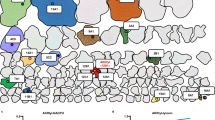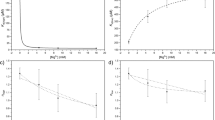Abstract
Enzymes are highly specific biocatalysts, yet they can promote unwanted side reactions. Here we investigated the factors that direct catalysis in the enoyl-thioester reductase Etr1p. We show that a single conserved threonine is essential to suppress the formation of a side product that would otherwise act as a high-affinity inhibitor of the enzyme. Substitution of this threonine with isosteric valine increases side-product formation by more than six orders of magnitude, while decreasing turnover frequency by only one order of magnitude. Our results show that the promotion of wanted reactions and the suppression of unwanted side reactions operate independently at the active site of Etr1p, and that the active suppression of side reactions is highly conserved in the family of medium-chain dehydrogenases/reductases (MDRs). Our discovery emphasizes the fact that the active destabilization of competing transition states is an important factor during catalysis that has implications for the understanding and the de novo design of enzymes.
This is a preview of subscription content, access via your institution
Access options
Access Nature and 54 other Nature Portfolio journals
Get Nature+, our best-value online-access subscription
$29.99 / 30 days
cancel any time
Subscribe to this journal
Receive 12 print issues and online access
$259.00 per year
only $21.58 per issue
Buy this article
- Purchase on Springer Link
- Instant access to full article PDF
Prices may be subject to local taxes which are calculated during checkout




Similar content being viewed by others
References
Khersonsky, O. & Tawfik, D.S. Enzyme promiscuity: a mechanistic and evolutionary perspective. Annu. Rev. Biochem. 79, 471–505 (2010).
Zhu, X.G., Long, S.P. & Ort, D.R. What is the maximum efficiency with which photosynthesis can convert solar energy into biomass? Curr. Opin. Biotechnol. 19, 153–159 (2008).
Browne, C.A. et al. Studies of the histidine residues of triose phosphate isomerase by proton magnetic resonance and x-ray crystallography. J. Mol. Biol. 100, 319–343 (1976).
Richard, J.P. Kinetic parameters for the elimination reaction catalyzed by triosephosphate isomerase and an estimation of the reaction's physiological significance. Biochemistry 30, 4581–4585 (1991).
Iyengar, R. & Rose, I.A. Concentration of activated intermediates of the fructose-1,6-bisphosphate aldolase and triosephosphate isomerase reactions. Biochemistry 20, 1223–1229 (1981).
Major, D.T., Freud, Y. & Weitman, M. Catalytic control in terpenoid cyclases: multiscale modeling of thermodynamic, kinetic, and dynamic effects. Curr. Opin. Chem. Biol. 21, 25–33 (2014).
Retey, J. Enzymatic reaction selectivity by negative catalysis or how do enzymes deal with highly reactive intermediates? Angew. Chem. Int. Edn. Engl. 29, 355–361 (1990).
Bar-Even, A., Milo, R., Noor, E. & Tawfik, D.S. The moderately efficient enzyme: futile encounters and enzyme floppiness. Biochemistry 54, 4969–4977 (2015).
Rosenthal, R.G. et al. Direct evidence for a covalent ene adduct intermediate in NAD(P)H-dependent enzymes. Nat. Chem. Biol. 10, 50–55 (2014).
Saraste, M. Oxidative phosphorylation at the fin de siècle. Science 283, 1488–1493 (1999).
Harwood, J.L. Fatty-acid metabolism. Annu. Rev. Plant Physiol. Plant Mol. Biol. 39, 101–138 (1988).
Quémard, A. et al. Enzymatic characterization of the target for isoniazid in Mycobacterium tuberculosis. Biochemistry 34, 8235–8241 (1995).
Stewart, M.J., Parikh, S., Xiao, G., Tonge, P.J. & Kisker, C. Structural basis and mechanism of enoyl reductase inhibition by triclosan. J. Mol. Biol. 290, 859–865 (1999).
Schmid, A. et al. Industrial biocatalysis today and tomorrow. Nature 409, 258–268 (2001).
Mansell, D.J. et al. Biocatalytic asymmetric alkene reduction: crystal structure and characterization of a double bond reductase from Nicotiana tabacum. ACS Catal. 3, 370–379 (2013).
Rosenthal, R.G. et al. The use of ene adducts to study and engineer enoyl-thioester reductases. Nat. Chem. Biol. 11, 398–400 (2015).
Airenne, T.T. et al. Structure-function analysis of enoyl thioester reductase involved in mitochondrial maintenance. J. Mol. Biol. 327, 47–59 (2003).
Torkko, J.M. et al. Candida tropicalis expresses two mitochondrial 2-enoyl thioester reductases that are able to form both homodimers and heterodimers. J. Biol. Chem. 278, 41213–41220 (2003).
Miwa, G.T., Garland, W.A., Hodshon, B.J., Lu, A.Y. & Northrop, D.B. Kinetic isotope effects in cytochrome P-450-catalyzed oxidation reactions. Intermolecular and intramolecular deuterium isotope effects during the N-demethylation of N,N-dimethylphentermine. J. Biol. Chem. 255, 6049–6054 (1980).
Khare, D. et al. Structural basis for cyclopropanation by a unique enoyl-acyl carrier protein reductase. Structure 23, 2213–2223 (2015).
Almarsson, O. & Bruice, T.C. Evaluation of the factors influencing reactivity and stereospecificity in NAD(P)H dependent dehydrogenase enzymes. J. Am. Chem. Soc. 115, 2125–2138 (1993).
Burgner, J.W. II & Ray, W.J. Jr. The lactate dehydrogenase catalyzed pyruvate adduct reaction: simultaneous general acid-base catalysis involving an enzyme and an external catalyst. Biochemistry 23, 3626–3635 (1984).
Benach, J., Atrian, S., Gonzàlez-Duarte, R. & Ladenstein, R. The catalytic reaction and inhibition mechanism of Drosophila alcohol dehydrogenase: observation of an enzyme-bound NAD-ketone adduct at 1.4 Å resolution by X-ray crystallography. J. Mol. Biol. 289, 335–355 (1999).
Bull, H.G. et al. Mechanism-based inhibition of human steroid 5 α-reductase by finasteride: enzyme-catalyzed formation of NADP-dihydrofinasteride, a potent bisubstrate analog inhibitor. J. Am. Chem. Soc. 118, 2359–2365 (1996).
Maier, T., Leibundgut, M. & Ban, N. The crystal structure of a mammalian fatty acid synthase. Science 321, 1315–1322 (2008).
Kwan, D.H. & Leadlay, P.F. Mutagenesis of a modular polyketide synthase enoylreductase domain reveals insights into catalysis and stereospecificity. ACS Chem. Biol. 5, 829–838 (2010).
Quade, N., Huo, L., Rachid, S., Heinz, D.W. & Müller, R. Unusual carbon fixation gives rise to diverse polyketide extender units. Nat. Chem. Biol. 8, 117–124 (2011).
Erb, T.J., Brecht, V., Fuchs, G., Müller, M. & Alber, B.E. Carboxylation mechanism and stereochemistry of crotonyl-CoA carboxylase/reductase, a carboxylating enoyl-thioester reductase. Proc. Natl. Acad. Sci. USA 106, 8871–8876 (2009).
Ames, B.D. et al. Crystal structure and biochemical studies of the trans-acting polyketide enoyl reductase LovC from lovastatin biosynthesis. Proc. Natl. Acad. Sci. USA 109, 11144–11149 (2012).
Erb, T.J. et al. Synthesis of C5-dicarboxylic acids from C2-units involving crotonyl-CoA carboxylase/reductase: the ethylmalonyl-CoA pathway. Proc. Natl. Acad. Sci. USA 104, 10631–10636 (2007).
Vlasie, M.D. & Banerjee, R. When a spectator turns killer: suicidal electron transfer from cobalamin in methylmalonyl-CoA mutase. Biochemistry 43, 8410–8417 (2004).
Toney, M.D. Controlling reaction specificity in pyridoxal phosphate enzymes. Biochim. Biophys. Acta 1814, 1407–1418 (2011).
Toney, M.D. Reaction specificity in pyridoxal phosphate enzymes. Arch. Biochem. Biophys. 433, 279–287 (2005).
Ghanem, M., Murkin, A.S. & Schramm, V.L. Ribocation transition state capture and rebound in human purine nucleoside phosphorylase. Chem. Biol. 16, 971–979 (2009).
Wilkins, M.R.C. et al. Protein identification and analysis tools in the ExPASy server. Methods Mol. Biol. 112, 531–552 (1999).
Dawson, R.M.C. Data for Biochemical Research (Clarendon Press, 1986).
Kabsch, W. XDS. Acta Crystallogr. D Biol. Crystallogr. 66, 125–132 (2010).
Winn, M.D. et al. Overview of the CCP4 suite and current developments. Acta Crystallogr. D Biol. Crystallogr. 67, 235–242 (2011).
Afonine, P.V. et al. phenix.model_vs_data: a high-level tool for the calculation of crystallographic model and data statistics. J. Appl. Crystallogr. 43, 669–676 (2010).
Murshudov, G.N., Vagin, A.A. & Dodson, E.J. Refinement of macromolecular structures by the maximum-likelihood method. Acta Crystallogr. D Biol. Crystallogr. 53, 240–255 (1997).
Emsley, P., Lohkamp, B., Scott, W.G. & Cowtan, K. Features and development of Coot. Acta Crystallogr. D Biol. Crystallogr. 66, 486–501 (2010).
Chen, V.B. et al. MolProbity: all-atom structure validation for macromolecular crystallography. Acta Crystallogr. D Biol. Crystallogr. 66, 12–21 (2010).
Acknowledgements
The authors thank R. Lill and U. Mühlenhoff at the Core Facility for Protein Spectroscopy and Protein Biochemistry at the University of Marburg for providing access to the stopped-flow instrument, and N.S. Cortina for analysis of high-resolution mass spectrometric analyses. This work was supported by the Max Planck Society and the European Research Council (ERC 637675 “SYBORG” to T.J.E.).
Author information
Authors and Affiliations
Contributions
R.G.R., B.V. and T.J.E. conceived and designed all experiments, with the exception of crystallography experiments, which they designed with T.W. and S.S. Enzyme kinetic assays and stopped-flow measurements were performed by R.G.R. and B.V. MS experiments were carried out and analyzed by B.V. and R.G.R. Crystallography experiments were carried out by B.V. and T.W. T.W. and B.V. collected the diffraction data, and T.W. interpreted the results. R.G.R., B.V. and T.J.E. wrote the paper.
Corresponding author
Ethics declarations
Competing interests
The authors declare no competing financial interests.
Supplementary information
Supplementary Text and Figures
Supplementary Results, Supplementary Tables 1–3 and Supplementary Figures 1–10 (PDF 1267 kb)
Rights and permissions
About this article
Cite this article
Rosenthal, R., Vögeli, B., Wagner, T. et al. A conserved threonine prevents self-intoxication of enoyl-thioester reductases. Nat Chem Biol 13, 745–749 (2017). https://doi.org/10.1038/nchembio.2375
Received:
Accepted:
Published:
Issue Date:
DOI: https://doi.org/10.1038/nchembio.2375



